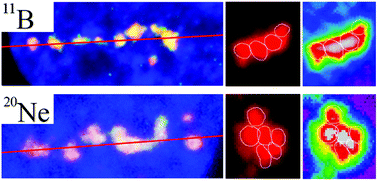Our official English website, www.x-mol.net, welcomes your
feedback! (Note: you will need to create a separate account there.)
Particles with similar LET values generate DNA breaks of different complexity and reparability: a high-resolution microscopy analysis of γH2AX/53BP1 foci.
Nanoscale ( IF 5.8 ) Pub Date : 2018-01-18 , DOI: 10.1039/c7nr06829h Lucie Jezkova 1, 2 , Mariia Zadneprianetc 3, 4 , Elena Kulikova 3, 4 , Elena Smirnova 5 , Tatiana Bulanova 3, 4 , Daniel Depes 6 , Iva Falkova 6 , Alla Boreyko 3, 4 , Evgeny Krasavin 3, 4 , Marie Davidkova 7 , Stanislav Kozubek 6 , Olga Valentova 2 , Martin Falk 6
Nanoscale ( IF 5.8 ) Pub Date : 2018-01-18 , DOI: 10.1039/c7nr06829h Lucie Jezkova 1, 2 , Mariia Zadneprianetc 3, 4 , Elena Kulikova 3, 4 , Elena Smirnova 5 , Tatiana Bulanova 3, 4 , Daniel Depes 6 , Iva Falkova 6 , Alla Boreyko 3, 4 , Evgeny Krasavin 3, 4 , Marie Davidkova 7 , Stanislav Kozubek 6 , Olga Valentova 2 , Martin Falk 6
Affiliation

|
Biological effects of high-LET (linear energy transfer) radiation have received increasing attention, particularly in the context of more efficient radiotherapy and space exploration. Efficient cell killing by high-LET radiation depends on the physical ability of accelerated particles to generate complex DNA damage, which is largely mediated by LET. However, the characteristics of DNA damage and repair upon exposure to different particles with similar LET parameters remain unexplored. We employed high-resolution confocal microscopy to examine phosphorylated histone H2AX (γH2AX)/p53-binding protein 1 (53BP1) focus streaks at the microscale level, focusing on the complexity, spatiotemporal behaviour and repair of DNA double-strand breaks generated by boron and neon ions accelerated at similar LET values (∼135 keV μm-1) and low energies (8 and 47 MeV per n, respectively). Cells were irradiated using sharp-angle geometry and were spatially (3D) fixed to maximize the resolution of these analyses. Both high-LET radiation types generated highly complex γH2AX/53BP1 focus clusters with a larger size, increased irregularity and slower elimination than low-LET γ-rays. Surprisingly, neon ions produced even more complex γH2AX/53BP1 focus clusters than boron ions, consistent with DSB repair kinetics. Although the exposure of cells to γ-rays and boron ions eliminated a vast majority of foci (94% and 74%, respectively) within 24 h, 45% of the foci persisted in cells irradiated with neon. Our calculations suggest that the complexity of DSB damage critically depends on (increases with) the particle track core diameter. Thus, different particles with similar LET and energy may generate different types of DNA damage, which should be considered in future research.
中文翻译:

具有相似LET值的粒子会产生不同复杂性和可修复性的DNA断裂:γH2AX/ 53BP1病灶的高分辨率显微镜分析。
高LET(线性能量转移)辐射的生物效应受到越来越多的关注,特别是在更有效的放射治疗和太空探索的背景下。高LET辐射对细胞的有效杀伤取决于被加速粒子产生复杂DNA损伤的物理能力,这在很大程度上由LET介导。但是,DNA的损伤和修复特性在暴露于具有相似LET参数的不同颗粒时仍未得到探索。我们使用高分辨率共聚焦显微镜在微观水平上检查了磷酸化的组蛋白H2AX(γH2AX)/ p53结合蛋白1(53BP1)的聚焦条纹,重点是复杂性,硼和氖离子产生的时空行为和DNA双链断裂的修复在相似的LET值(〜135 keVμm-1)和低能量(分别为n和8 MeV / n)下加速。使用锐角几何体照射细胞,并进行空间(3D)固定,以最大程度地提高这些分析的分辨率。与低LETγ射线相比,两种高LET辐射类型均生成高度复杂的γH2AX/ 53BP1聚焦簇,其尺寸更大,不规则性增加且消除速度较慢。出乎意料的是,与DSB修复动力学相一致,氖离子比硼离子产生更复杂的γH2AX/ 53BP1聚焦簇。尽管细胞在γ射线和硼离子的照射下在24小时内消除了绝大多数病灶(分别为94%和74%),但仍有45%的病灶持续存在于用氖照射的细胞中。我们的计算表明,DSB破坏的复杂性主要取决于(增加)粒子轨道芯的直径。因此,具有相似的LET和能量的不同粒子可能会产生不同类型的DNA损伤,这应在以后的研究中加以考虑。
更新日期:2017-12-12
中文翻译:

具有相似LET值的粒子会产生不同复杂性和可修复性的DNA断裂:γH2AX/ 53BP1病灶的高分辨率显微镜分析。
高LET(线性能量转移)辐射的生物效应受到越来越多的关注,特别是在更有效的放射治疗和太空探索的背景下。高LET辐射对细胞的有效杀伤取决于被加速粒子产生复杂DNA损伤的物理能力,这在很大程度上由LET介导。但是,DNA的损伤和修复特性在暴露于具有相似LET参数的不同颗粒时仍未得到探索。我们使用高分辨率共聚焦显微镜在微观水平上检查了磷酸化的组蛋白H2AX(γH2AX)/ p53结合蛋白1(53BP1)的聚焦条纹,重点是复杂性,硼和氖离子产生的时空行为和DNA双链断裂的修复在相似的LET值(〜135 keVμm-1)和低能量(分别为n和8 MeV / n)下加速。使用锐角几何体照射细胞,并进行空间(3D)固定,以最大程度地提高这些分析的分辨率。与低LETγ射线相比,两种高LET辐射类型均生成高度复杂的γH2AX/ 53BP1聚焦簇,其尺寸更大,不规则性增加且消除速度较慢。出乎意料的是,与DSB修复动力学相一致,氖离子比硼离子产生更复杂的γH2AX/ 53BP1聚焦簇。尽管细胞在γ射线和硼离子的照射下在24小时内消除了绝大多数病灶(分别为94%和74%),但仍有45%的病灶持续存在于用氖照射的细胞中。我们的计算表明,DSB破坏的复杂性主要取决于(增加)粒子轨道芯的直径。因此,具有相似的LET和能量的不同粒子可能会产生不同类型的DNA损伤,这应在以后的研究中加以考虑。









































 京公网安备 11010802027423号
京公网安备 11010802027423号